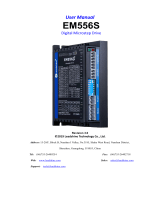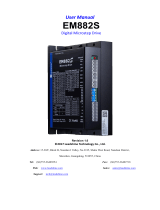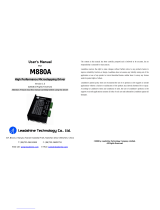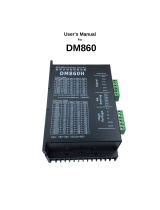Page is loading ...

Hardware Installation Manual for
DM805-AI
Digital Stepper Drive with Analog 0-5V Input
www.leadshine.com
HWMN-DMAI-R20110627

ii
HWMN-DMAI-R20110627
Leadshine reserves the right to make changes without further notice to any products
herein to improve reliability, function or design. Leadshine does not assume any
liability arising out of the application or use of any product or circuit described
herein; neither does it convey any license under its patent rights of others.
Leadshine’s general policy does not recommend the use of its products in life
support or aircraft applications wherein a failure or malfunction of the product may
directly threaten life or injury. According to Leadshine’s terms and conditions of
sales, the user of Leadshine’s products in life support or aircraft applications
assumes all risks of such use and indemnifies Leadshine against all damages.
©2011 by Leadshine Technology, All Rights Reserved
Change Log
Revision Date
Changes
Version
2011-6-27
Original Create
MN-DMAI-R20110627

iii
HWMN-DMAI-R20110627
Safety Items
!
Notice
Read this manual carefully before trying to install the stepper drive into your system. The person
setup the stepper drive should have a better understanding on electronics and mechanics. Contact
Leadshine technical guys when have questions on this document.
!
Caution
Make sure the power supply voltage dose not exceed the drive’s input range. Double check the
connections and make sure the power lead polarity is correct.
!
Warning
Do not set high current to small stepper motor. It is possible that the motor will be damaged.
!
Caution
Disconnect the motor from the load if you are not sure the move direction. Adjust the axis in the
middle before trying to run the motor.
!
Warning
Never disconnect the motor lead when the power source is energized.

iv
HWMN-DMAI-R20110627
Table of Contents
1. Introduction, Features and Applications........................................................................................................................ 1
Introduction................................................................................................................................................................ 1
Features.......................................................................................................................................................................1
Applications................................................................................................................................................................1
2. Specifications................................................................................................................................................................. 2
General Specifications................................................................................................................................................2
Electrical Specifications.............................................................................................................................................2
Input Voltage.......................................................................................................................................................2
Pulse Input Frequency........................................................................................................................................2
Velocity Control................................................................................................................................................. 2
Operating Environment.............................................................................................................................................. 2
Mechanical Specifications..........................................................................................................................................3
Elimination of Heat.................................................................................................................................................... 3
3. Connectors and Interface................................................................................................................................................4
4. Operating Mode..............................................................................................................................................................5
Analog 0-5V Speed Mode..........................................................................................................................................5
Signal Sequence................................................................................................................................................. 6
Ramp Shaping.................................................................................................................................................... 6
Low/High Speed Mode.............................................................................................................................................. 7
Signal Sequence................................................................................................................................................. 7
Ramp Shaping.................................................................................................................................................... 8
External Potentiometer Mode.....................................................................................................................................8
Signal Sequence................................................................................................................................................. 9
Ramp Shaping.................................................................................................................................................... 9
Pulse/Direction Mode...............................................................................................................................................10
5. Control Signal Requirement.........................................................................................................................................10
Pulse/Direction Mode...............................................................................................................................................10
6. Connecting the Motor...................................................................................................................................................11
4-lead Motors Connections...................................................................................................................................... 11
6-lead Motors Connections...................................................................................................................................... 11
Half Coil Configurations..................................................................................................................................11
Full Coil Configurations...................................................................................................................................11
8-lead Motors Connections...................................................................................................................................... 12
Series Connections........................................................................................................................................... 12
Parallel Connections.........................................................................................................................................12
7. Power Supply Selection................................................................................................................................................13
Regulated or Unregulated Power Supply.................................................................................................................13
Multiple Drives.........................................................................................................................................................13
Selecting Supply Voltage..........................................................................................................................................13
8. Typical Connection.......................................................................................................................................................15

v
HWMN-DMAI-R20110627
Analog 0-5V Speed Mode........................................................................................................................................15
Low/High Speed Mode............................................................................................................................................ 16
External Potentiometer Mode...................................................................................................................................17
Pulse/Direction Mode...............................................................................................................................................18
9. Wiring Notes.................................................................................................................................................................18
10. Configure the Drive....................................................................................................................................................19
Auto Configuration by SW4.................................................................................................................................... 19
Selecting Operating Mode........................................................................................................................................20
Microstep Resolution Selection............................................................................................................................... 20
Current Settings........................................................................................................................................................20
Dynamic current setting................................................................................................................................... 20
Idle current setting............................................................................................................................................21
11. Protection Functions...................................................................................................................................................22
Over-current Protection....................................................................................................................................22
Over-voltage Protection................................................................................................................................... 22
Protection Indications.......................................................................................................................................22
12. Frequently Asked Questions.......................................................................................................................................23
Problem Symptoms and Possible Causes.................................................................................................................23
APPENDIX...................................................................................................................................................................... 24
Twelve Month Limited Warranty............................................................................................................................. 24
Exclusions........................................................................................................................................................ 24
Obtaining Warranty Service............................................................................................................................. 24
Warranty Limitations........................................................................................................................................24
Shipping Failed Product...................................................................................................................................24
CONTACT US..................................................................................................................................................................25

DM805-AI Hardware Installation Manual
1
HWMN-DM-R2011060
1. Introduction, Features and Applications
Introduction
The DM805-AI is a 0-5V input stepper drive with built-in oscillator which is based on the latest digital control algorithm. It brings a
unique level of system smoothness, providing optimum torque and nulls mid-range instability. Motor self-test and parameter auto-setup
technology offers optimum responses with different motors and easy-to-use. The driven motors can run with much smaller noise, lower
heating, smoother movement than most of the drivers in the markets. Its unique features make the DM805-AI an ideal solution for
applications that require low-speed smoothness.
The three built-in potentiometers are used to preset and adjust the velocity, acceleration and deceleration. In 0-5V speed mode, the motor
speed is controllable and follows the analog 0-5V input. In Low/HIGH speed mode, the motor speed is selected by digital input and
adjusted by the high/low speed potentiometers. The user can run the motor with the least configuration and connection. In position mode,
the DM805-AI is a traditional stepper drive. There is a 5V power supply output for customer use.
Features
Anti-Resonance, provides optimum torque and nulls mid-range instability
Motor self-test and parameter auto-setup technology, offers optimum responses with different motors
Multi-Stepping allows a low resolution step input to produce a higher microstep output for smooth system performance
Command Source: 0-5V, built-in potentiometer and pulse
Two preset velocity and adjust by built-in potentiometer
Preset acceleration/deceleration and adjust by built-in potentiometer
Velocity control mode via analog 0-5V and position control mode via pulse
Built-in pulse generator nulls external motion controller
Supply voltage up to +80 VDC
Output current programmable, from 0.3A -5.0A(RMS)
TTL compatible and optically isolated digital input
Automatic current reduction
Over-voltage, over-current, phase-error protections
Applications
This drive is suitable for the application which needs to adjust the velocity via the potentiometer or analog 0-5V command. It can work
with the NEMA17/23/34 stepper motor to replace the brushless motor with gearbox due to its high torque and less motor noise at low
speed. If necessary, it can be used in various kinds of machines, such as rotary heat exchange, conveyor belts, transport vehicle, laser
cutters, laser markers, high precision X-Y tables, labeling machines, and so on.

DM805-AI Hardware Installation Manual
2
HWMN-DM-R2011060
2. Specifications
General Specifications
Parameter
Min
Typical
Max
Unit
Isolation Resistance
500
-
-
MΩ
Logic Signal Current
7
10
16
mA
Electrical Specifications
Input Voltage
Input Voltage
Drive Model
Min
Typical
Max
Unit
DM805-AI
18
60
80
VDC
Pulse Input Frequency
Pulse Input Frequency
Drive Model
Min
Typical
Max
Unit
DM805-AI
0
-
200
kHz
Velocity Control
Item
Specification
Dead Band
Resolution
Min
Max
Analog Input
0-5V Speed Mode
0-5 V
10 mV
10 mV
0 Rev/s
25 ± 0.5 Rev/s
External POT
Mode
20 mV
Accel / Decel / Ramp Potentiometer
0-25 turns
10 mV
10 mV
0.5 Rev/s2
250 ± 1 Rev/s2
LoSpeed Potentiometer
0-25 turns
10 mV
10 mV
0 Rev/s
5 ± 0.01 Rev/s
HiSpeed Potentiometer
0-25 turns
10 mV
10 mV
0 Rev/s
25 ± 0.5 Rev/s
Operating Environment
Cooling
Natural Cooling or Forced cooling
Operating
Environment
Environment
Avoid dust, oil fog and corrosive gases
Ambient Temperature
0℃ - 50℃(32℉ - 122℉)
Humidity
40%RH -90%RH
Operating
Temperature
70℃(158℉) Max

DM805-AI Hardware Installation Manual
3
HWMN-DM-R2011060
Vibration
5.9m/s2Max
Storage Temperature
-20℃ - 65℃(-4℉-149℉)
Mechanical Specifications
34 [ 1.339]
75.5 [ 2.972]
47.8 [ 1.882]
112 [ 4.409]
4-R1.75[ 0.069]
25.3 [ 0.996]
9.25 [ 0.364]
4.5 [ 0.177]
112 [ 4.409]
118 [ 4.646]
Elimination of Heat
Driver’s reliable working temperature should be <70℃(158℉), and motor working temperature should be <80℃(176℉);
It is recommended to use automatic idle-current mode, namely current automatically reduce to 60% when motor stops, so as to
reduce driver heating and motor heating;
It is recommended to mount the driver vertically to maximize heat sink area. Use forced cooling method to cool the system if
necessary.

DM805-AI Hardware Installation Manual
4
HWMN-DM-R2011060
3. Connectors and Interface
The DM805-AI has three connectors, connector for digital I/O signals connections, connector for analog 0-5V signal connections and
connector for power and motor connections. The three parameters are used to preset or adjust the speed, acceleration and deceleration
ramp. They have different functions in different modes. The green indicator turns on when the drive is powered on. When error happens,
the red indicator flashes periodicity to indicate the error type.
Power Connector, 6-pin screw terminal, 3.81 mm space
Digital I/O Signal Connector, 6-pin screw terminal, 3.81 mm
space
Analog Signal Connector, 6-pin screw terminal, 3.81 mm
space
Indicator Green: Power, Red: Fault
Potentiometers Adjusting Speed, Acceleration, Deceleration
RS232 communication port, RJ11, communicating PC software
Note: It is used to configure and current loop tuning, anti-resonance
tuning with the PC software. However, the drive can still work
properly without it. The DM805-AI can be fully tuned by the the
auto-tuning..
DIP switch, 8 bits, current setting, selecting microstep, operating mode
Auto Tuning: Switch SW4 two times in one second.

DM805-AI Hardware Installation Manual
5
HWMN-DM-R2011060
4. Operating Mode
The DM805-AI supports four operating modes selected by the DIP switch SW7 and SW8, shown as the following table.
Mode
SW7
SW8
Description
0~5V Speed
on
on
Analog 0-5V Speed Mode
Lo/Hi Speed
off
on
Low and High Speed Mode
External POT
on
off
External Potentiometer Speed Mode
Pulse/Direction
off
off
Pulse and Direction Position Mode
Analog 0-5V Speed Mode
In this mode motor speed follows the analog 0-5V input voltage. Motor speed is also proportional to the HiSpeed potentiometer.
Direction input controls the motor direction. The actual motor speed is calculated as follows:
Turns
terPotentiomeHiSpeedofTurns
V
InputAna
(RPS)Speed(RPS) 255
log
5.025
5V
0
Motor Speed
Fully CW of HiSpeed Potentiometer
Analog
Input
25±0.5rps
Half CW of HiSpeed Potentiometer
Dead Band

DM805-AI Hardware Installation Manual
6
HWMN-DM-R2011060
Signal Sequence
After power-up, the DM805-AI does not response to the analog 0-5V input immediately. The Enable and Run signal should be activated
prior to the analog 0-5V input. The drive is enabled when the Enable/Disable input is unconnected and the motor shaft has holding
torque at that time. After Run signal is active, the motor speed follows the analog 0-5V input.
Enable/Disable
Run/Stop
Direction
0-5V Input
Positive Negative
Run Stop
Low Speed
High Speed
Enable
Ramp Shaping
There are two potentiometers Accel and Decel for adjusting the acceleration ramp and deceleration ramp, respectively. When the input
ramp exceeds the value set by the potentiometer, the actual output ramp will be limited by the potentiometer value.
Motor Speed
Shaped by the Accel Potentiometer
Time
Shaped by the Decel Potentiometer
Positive
Direction
Negative
Direction
Actual Speed
Command Speed

DM805-AI Hardware Installation Manual
7
HWMN-DM-R2011060
Low/High Speed Mode
In low/high speed mode, motor speed is fixed to the value adjusted by the LoSpeed or HiSpeed Potentiometer, depending on the level
of Speed input. When the Speed input is LOW level, the maximum motor speed adjusted by the LoSpeed potentiometer is 5rps. When
the Speed input is HIGH level, the maximum motor speed adjusted by the HighSpeed is 25rps.
25 turns0
Motor Speed
HiSpeed Potentiometer
Potentiometer
LoSpeed Potentiometer
Dead Band
25±0.5rps
5±0.02rps
Signal Sequence
After power-up, the DM805-AI does not make the motor run immediately. The Enable and Run signal should be activated firstly. Drive
is enabled when the Enable/Disable input is unconnected. After Run signal is activated, the Speed can be applied to the drive for
low/high speed selection.

DM805-AI Hardware Installation Manual
8
HWMN-DM-R2011060
Enable/Disable
Run/Stop
Direction
Speed
High
Speed Low Speed
Positive Negative
Run Stop
Enable
Ramp Shaping
When motor speed switches between low and high or changes direction, the acceleration/deceleration ramp adjusted by the Ramp
potentiometer will be inserted automatically for smooth motion.
Note: Do not adjust too small or too high Ramp. Otherwise the stepper motor may stall when switching between low and high speed.
Motor Speed
Shaped by Ramp Potentiometer
Time
Actual Speed
Command Speed
Shaped by Ramp Potentiometer
Low Speed
High Speed
External Potentiometer Mode
In this mode motor speed follows the analog 0-5V input voltage. Motor speed is also proportional to the HiSpeed potentiometer. When
the analog input is 0-2.5V, the motor runs in negative direction. While the analog input is 2.5-5V, the motor runs in positive direction.

DM805-AI Hardware Installation Manual
9
HWMN-DM-R2011060
5V
0V
Motor Speed
Fully CW of HiSpeed Potentiometer
Analog
Input
-25rps
25rps
0rps
Half CW of HiSpeed Potentiometer
2.5V
Dead Band
Signal Sequence
Enable/Disable
Run/Stop
2.5-5V Input
Run Stop
Positive Direction
Negative Direction
0-2.5V Input
Ramp Shaping
There are two potentiometers Accel and Decel for adjusting the acceleration ramp and deceleration ramp, respectively. When the input
ramp exceeds the value set by the potentiometer, the actual output ramp will be limited by the potentiometer value.

DM805-AI Hardware Installation Manual
10
HWMN-DM-R2011060
Motor Speed
Shaped by the Accel Potentiometer
Time
Shaped by the Decel Potentiometer
Positive
Direction
Negative
Direction
Actual Speed
Command Speed
Pulse/Direction Mode
In this mode motor speed is the proportional to the pulse input frequency and motor rotary angle is controlled by the pulse counts. The
microstep can be selected by the DIP switch SW5 and SW6.
5. Control Signal Requirement
Pulse/Direction Mode
DM805-AI can support Pulse/Direction and CW/CCW control signal modes. In order to avoid some fault operations and deviations,
PUL, DIR and ENA should abide by some rules, shown as following diagram:
URemark:
a) ENA must be ahead of DIR by at least 5us. Usually, ENA+ and ENA- are NC (not connected).

DM805-AI Hardware Installation Manual
11
HWMN-DM-R2011060
b) DIR must be ahead of PUL active edge by 5us to ensure correct direction;
c) Pulse width not less than2.5us;
d) Low level width not less than 2.5us.
6. Connecting the Motor
The DM805-AI can drive any 2-pahse and 4-pahse hybrid stepping motors.
4-lead Motors Connections
4 lead motors are the least flexible but easiest to wire. Speed and torque will depend on winding inductance. In setting the drive output
current, multiply the specified phase current by 1.4 to determine the peak output current.
6-lead Motors Connections
Like 8 lead stepping motors, 6 lead motors have two configurations available for high speed or high torque operation. The higher speed
configuration, or half coil, is so described because it uses one half of the motor’s inductor windings. The higher torque configuration, or
full coil, uses the full windings of the phases.
Half Coil Configurations
As previously stated, the half coil configuration uses 50% of the motor phase windings. This gives lower inductance, hence, lower
torque output. Like the parallel connection of 8 lead motor, the torque output will be more stable at higher speeds. This configuration is
also referred to as half chopper. In setting the drive output current multiply the specified per phase (or unipolar) current rating by 1.4 to
determine the peak output current.
Full Coil Configurations
The full coil configuration on a six lead motor should be used in applications where higher torque at lower speeds is desired. This
configuration is also referred to as full copper. In full coil mode, the motors should be run at only 70% of their rated current to prevent
over heating.

DM805-AI Hardware Installation Manual
12
HWMN-DM-R2011060
8-lead Motors Connections
8 lead motors offer a high degree of flexibility to the system designer in that they may be connected in series or parallel, thus satisfying a
wide range of applications.
Series Connections
A series motor configuration would typically be used in applications where a higher torque at lower speeds is required. Because this
configuration has the most inductance, the performance will start to degrade at higher speeds. In series mode, the motors should also be
run at only 70% of their rated current to prevent over heating.
Parallel Connections
An 8 lead motor in a parallel configuration offers a more stable, but lower torque at lower speeds. But because of the lower inductance,
there will be higher torque at higher speeds. Multiply the per phase (or unipolar) current rating by 1.96, or the bipolar current rating by
1.4, to determine the peak output current.
UNEVERUdisconnect or connect the motor while the power source is energized.

DM805-AI Hardware Installation Manual
13
HWMN-DM-R2011060
7. Power Supply Selection
The DM805-AI can match medium and small size stepping motors (from NEMA frame size 14 to 34) made by Leadshine or other motor
manufactures around the world. To achieve good driving performances, it is important to select supply voltage and output current
properly. Generally speaking, supply voltage determines the high speed performance of the motor, while output current determines the
output torque of the driven motor (particularly at lower speed). Higher supply voltage will allow higher motor speed to be achieved, at
the price of more noise and heating. If the motion speed requirement is low, it’s better to use lower supply voltage to decrease noise,
heating and improve reliability.
Regulated or Unregulated Power Supply
Both regulated and unregulated power supplies can be used to supply the drive. However, unregulated power supplies are preferred due
to their ability to withstand current surge. If regulated power supplies (such as most switching supplies.) are indeed used, it is important
to have large current output rating to avoid problems like current clamp, for example using 4A supply for 3A motor-drive operation. On
the other hand, if unregulated supply is used, one may use a power supply of lower current rating than that of motor (typically 50%~
70% of motor current). The reason is that the drive draws current from the power supply capacitor of the unregulated supply only during
the ON duration of the PWM cycle, but not during the OFF duration. Therefore, the average current withdrawn from power supply is
considerably less than motor current. For example, two 3A motors can be well supplied by one power supply of 4A rating.
Multiple Drives
It is recommended to have multiple drives to share one power supply to reduce cost, if the supply has enough capacity. To avoid cross
interference, DO NOT daisy-chain the power supply input pins of the drives. Instead, please connect them to power supply separately.
Selecting Supply Voltage
The power MOSFETS inside the DM805-AI can actually operate with wider voltage range than the input specification. Higher supply
voltage can increase motor torque at higher speeds, thus helpful for avoiding losing steps. However, higher voltage may cause bigger
motor vibration at lower speed, and it may also cause over-voltage protection or even drive damage. Therefore, it is suggested to choose
only sufficiently high supply voltage for intended applications, and it is suggested to use power supplies with theoretical output voltage
of drive’s minimum + 10% to drive’s maximum – 10%, leaving room for power fluctuation and back-EMF.

DM805-AI Hardware Installation Manual
14
HWMN-DM-R2011060
The recommended power supply voltage for DM805-AI is 24-72VDC:

DM805-AI Hardware Installation Manual
15
HWMN-DM-R2011060
8. Typical Connection
Analog 0-5V Speed Mode
The 5V output of DM805-AI is connected to the COM+. The input signal is activated when it is short circuit to the signal GND. When
the Limit switch is activated, the motor shaft will be free and the red indicator is on.
Accel
Decel
HiSpeed
DM805-AI
Motor
20-80VDC
Disable
-Limit
Direction
Run/Stop
0~5V
COM+
Run/Stop/Pulse
Direction/+Limit
Speed/(-)Limit
Enable/Disable
Signal GND
+5V Output
0~5V Input
Signal GND
Signal GND
Power GND
+20-80VDC
Motor A+
Motor A-
Motor B+
Motor B-
Accel/Ramp
Decel/LoSpeed
HiSpeed
/











